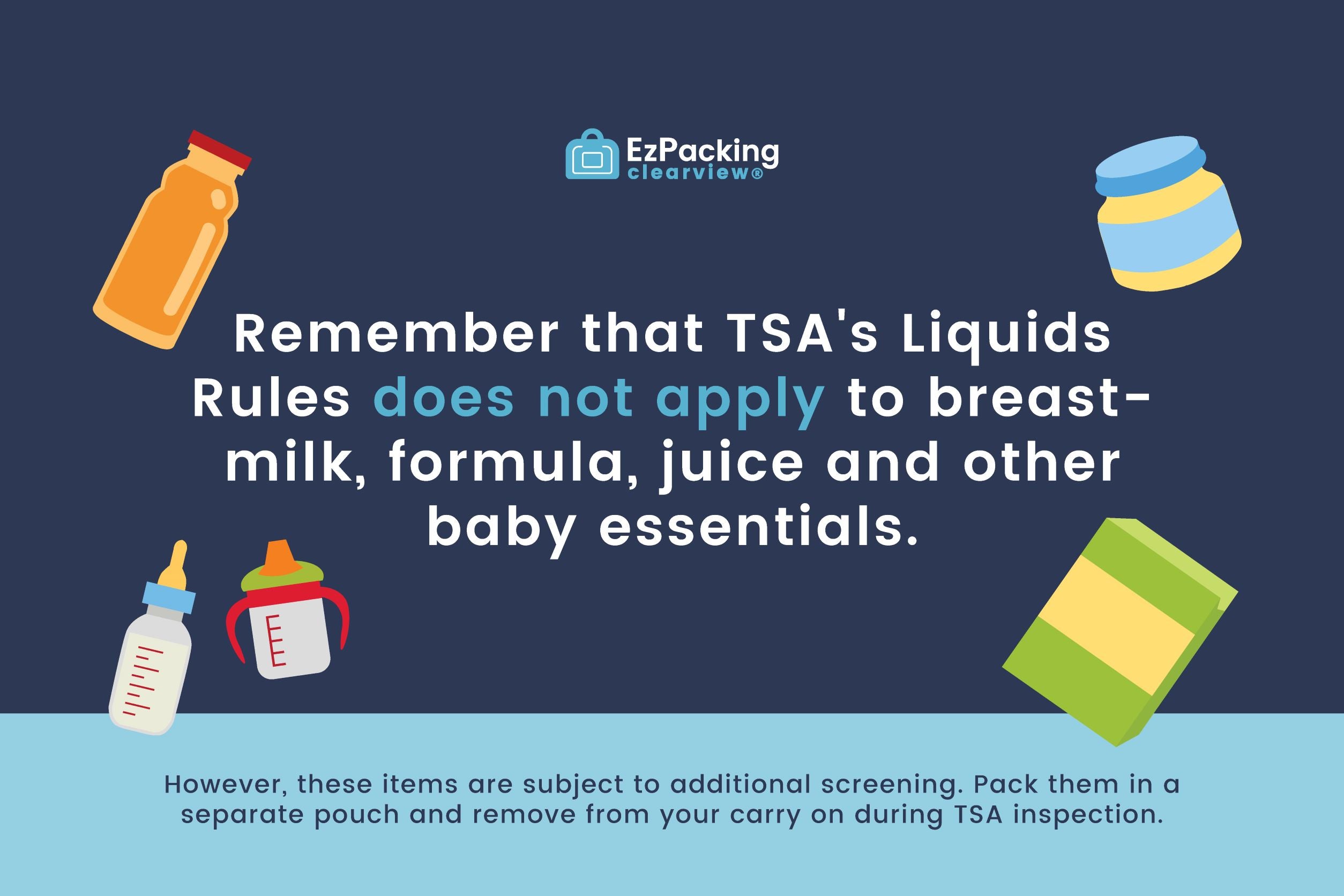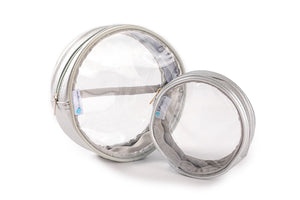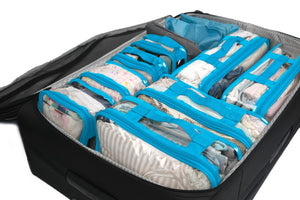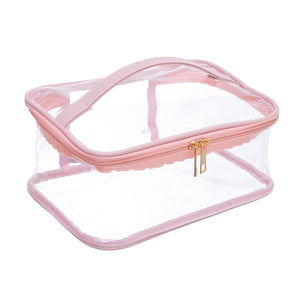3 Essential Airplane Rules When Flying With a Newborn
Posted by Dianne Chen on
Intro | Newborn Flight Safety | International Vs Domestic | TSA 3.4 Ounce Rule Exemption | Free Packing List | FAQ | COVID Update
Air travel with a baby - especially a newborn - requires a lot of careful planning, from booking your seats to every necessary inflight detail. Some airlines provide special equipment for passengers with newborns, such as baby bassinets and car seats. These privileges should be arranged early on since some of the these are not typically carried on board.
If you're planning on flying with a newborn, here are some things you definitely should consider:
1. NEWBORN FLIGHT SAFETY

Some airlines admit newborns as early as 2 weeks old while others only allow 2 month old babies and above. Traveling with your newborn usually requires a medical release form before airlines accept you onto the flight. Unless completely necessary, pediatricians do not advise parents to travel with a newborn 1 month old and under.
The most important reason being that the mother needs postpartum rest and the baby needs a stable environment right after birth. In-flight conditions such as noise, cabin temperature changes and pressure maybe very uncomfortable to the newborn. Also, the baby's immune system is still fragile and could be affected by the germs carried onto the plane. Air Canada and United Airlines do make cut-offs at 7 days old while Southwest Airlines requires medical releases for infant under 2 weeks old.
It's always a good idea to bring a birth certificate to verify your baby's age. Verify with your airlines for their specific rules.
COVID-19 Update (2020): In light of recent events, the CDC recommends to avoid all non-essential travel with your baby. Please visit the CDC website for more travel tips and COVID-19 updates.
2. INTERNATIONAL FLIGHT VERSUS DOMESTIC?

There is no "blanket fare rule" for flying with a newborn. Most airlines allow newborn babies to fly for free (on a domestic flight) as long as they are seated on the lap of the mommy or daddy (or the paying passenger). As a general rule, only one infant should remain in the lap of an adult. While it is free for domestic flights, be prepared to pay 10-25% of a full adult fare when flying internationally, depending on taxes and other conditions.
Air Canada, for example, flies lap-seated infants for free when traveling within Canada or between United States and Canada, but requires a 10% of adult fare payment when flying with your newborn internationally. United Airlines charges regular fare for infants regardless of seating for international flights. Others like Qatar Airways, Singapore Airlines and Emirates charge 10% of adult fare even when flying with your newborn for a domestic flight.
Although some airlines do not allow children below 2 years old to occupy their own seat, others would ask you to buy an additional seat for safety. Turbulence might cause serious injury to a lap-seated newborn without a fastened safety belt. When buying additional seats for your baby, most airlines like Air Canada would charge depending on the route and length of travel. Other airlines automatically charge 50% -75% of an adult fare.
You may also request for baby bassinets or sky cots that provide a miniature bed for infants 8 months and under. Make sure to confirm availability of a baby bassinet prior to your scheduled flight because not all airlines carry this inflight. Should you decide to bring your baby’s own car seat, always check with your airline beforehand if your car seat is allowed inside the plane. Only target FAA approved car seats or restraining seats are allowed inside a plane.
If an airline requires you to purchase a ticket for your infant, make sure to:
Reserve two seats together, ideally near the aisle so changing diapers and using the restroom are easily accessible. As general tip, first row seats and emergency exit row are not suitable for passengers with infants.
3. TSA 3.4 OUNCE RULE EXEMPTION
For breastfeeding mothers, remember that the regulation on liquids that limits you to 3.4 ounces does not apply to breast milk. Formula, breast milk, and juice in quantities greater than 3.4 ounces or 100 milliliters are allowed in carry-on baggage and do not need to fit within a quart-sized bag. Ice packs, frozen gel packs and other accessories required to cool formula are also allowed in your carry-on. If these accessories are partially frozen or slushy, they may be subject to additional screening. You may also bring gel or liquid-filled teethers, canned, jarred and processed baby food in carry-on baggage.
TIP #1:
Remove these items from your carry-on bag to be screened separately from the rest of your belongings. Use our clear toiletry bag for packing TSA approved liquids (other than breastmilk).
-
IMPORTANT: You do not need to travel with your newborn to bring breast milk.
TIP #2:
As soon as you get on board, place your baby bag under the seat in front of you for easy access to things you might need during the flight such as diapers, extra clothes and tissues and wet wipes. The next tip will keep all your essentials in check (and organized)!
TIP #3:
Make your life easier by organizing your essential baby items neatly inside a travel packing cube so you can easily grab them during the flight. Use a small cube for items such as tissues, wet wipes and extra diapers. Use a medium size cube for a change of clothes, diaper kit and feeding bottles. If you happen to bring along a sling-type baby carrier, make sure you place it in a specific place to avoid clutter in the baby bag, making it easy to grab once the plane lands.
Flying with your newborn baby might happen earlier than expected, because well, life happens, but it doesn’t have to be a hassle for you. Just be certain to stay updated with the specific rules of the airline you are flying with to ensure a smooth travel experience.
Always keep in mind these 3 important items:
1. Newborn flight safety
2. Booking the Best Seat / Baby bassinet / FAA Approved Car Seat
3. TSA 3.4 Ounce Rule Exception
Plus, staying calm and organized for your little one is important for your sanity!
You want to create a safe and happy environment when you're flying with a newborn!
Enjoy your trip!
P.S. Click here for our post on The Best Flying Tips for Airplane Travel.
FREQUENTLY ASKED QUESTIONS (FAQS):
How early can you fly with a newborn baby?
Airlines have varying regulations about how early they allow a newborn to fly. It’s best to check with the specific airline you’re flying with. In general, most airlines allow babies at least 2 weeks old to fly.
Here’s a list of popular US airlines and their newborn regulations as of October 2018 (make sure to check again in case of any changes):
|
Airline |
Newborn Regulation |
|
No minimum age required |
|
|
Accepts infants as young as 2 days old but must present medical form from physician (2 to 7 days old infants) |
|
|
Newborns under 7 days old aren’t allowed to travel unless there’s a physician’s medical form giving permission for the flight |
|
|
Only accepts newborns aged 7 days and above |
|
|
Permits newborns below 7 days old to fly as long as there’s a letter of approval from the physician |
|
|
Infants under 3 days old aren’t allowed to fly with this airline |
|
|
Requires a medical release for travel for infants under 14 days old |
|
|
Infants aged 7 days and below requiring an incubator or life support system aren’t allowed to board the plane |
|
|
Infants less than 7 days old aren’t allowed on any flight for this airline |
|
|
Infants under 7 days old aren’t allowed to travel on United Airlines |
Do I need an ID for my baby to fly?
It’s better to be prepared when you’re flying with a newborn. On domestic flights, you’re not required to bring an identification proof. BUT since you’re technically flying with a lap infant, you might be asked to present your baby’s proof of age. This could be in the form of your baby’s birth certificate, passport or immunization records. Traveling internationally? Your baby is required to present an identification proof or passport.
Is it safe for a newborn to fly?
When it comes to the safety of flying with a newborn, two issues come up. Health is one of those. Newborns just don’t have a developed immune system yet! They could get germs from the air or things around them. This is one of the risks of taking a flight with a young baby. Another issue is injuries or turbulence. Most newborns fly as lap infants meaning they are held by either mom or dad during the flight. The Federal Aviation Administration (FAA) advocate against this. No matter how good your grip is, it’s hard to securely hold your newborn in times of turbulence or worse, accidents.
Solving these issues:
✓ Health - First off, make sure your baby is in perfect health condition before even booking that flight! If in doubt, a trip to the pediatrician is not a bad idea. In fact, as mentioned above, some airlines require a health certificate from a physician for babies under certain ages. Once you board, sanitize any surface or object that your little one can be in contact with! This lessens the chance of acquiring germs or bacterias and the baby getting sick.
✓ Injury / Turbulence - The FAA advises the use of child safety restraint systems. Here’s a guide on what the FAA considers as safe restraint systems for aircraft use. You’re also allowed to bring your own FAA-approved car seat on board. The problem is if the baby is a lap infant. Ask ahead, the airline might be able to give you a vacant seat to secure your baby during the flight!
Do newborns need a passport?
Any child under 2 years of age might be required to present a proof of age. A passport is one form of proof of age, along with a birth certificate or immunization record. For domestic travels, what matters is that you have a proof of age, not necessarily a passport. For international travels, babies are required to present a passport, no matter the age.
Do newborns fly free?
Babies under 2 years old (without a seat) can fly free for domestic flights within the US. For international flights, lap infants are required to pay a certain percentage of the adult fare and/or taxes. Planning to buy a separate seat for your newborn? You’ll have to pay a part of the full adult fare (sometimes even the full adult fare) for his or her seat.
Here’s a breakdown of the different airline ticket costs for newborns as of October 2018:
|
Airline |
Domestic Flight (Lap Infant) |
International Flight (Lap Infant) |
International Flight (Own Seat) |
|
Free |
$17 in fees (From international destination to the US) |
Full adult fare |
|
|
Free |
10% of adult fare and taxes may apply |
25% discounted ticket rate |
|
|
Free (Ticket required) |
10% of adult fare |
Country-specific discounts may apply |
|
|
Free |
Free |
Full adult fare |
|
|
Free |
10% of adult fare, plus taxes and fees |
75% of adult fare, plus taxes and fees |
|
|
Free |
Fees and taxes apply |
Full adult fare |
|
|
Free |
Fees and taxes apply |
Offers infant fares for children under 2 years old |
|
|
Free |
Fees and taxes apply |
Full adult fare |
|
|
Free |
Fees and taxes apply |
Full adult fare |
|
|
Free |
10% of adult fare |
Full adult fare |
Can you take a carseat on a plane?
If you’ve purchased a seat for your newborn, you’re allowed to bring a carseat with you at no additional charge. However, make sure that it’s FAA approved and fits within the seat dimensions of your airline.
How to fly safely with a newborn during a virus outbreak?
Again, the CDC recommends to avoid non-essential travel (especially with babies and children) due to the COVID-19 pandemic. But if you’re in a situation where you can’t avoid to travel with your newborn, here are some precautions you can take to stay safe:
1. Consult with the baby’s pediatrician - The doctor can advise you on how to stay safe and healthy if you can’t avoid traveling during a pandemic.
2. A First Aid Kit is a must - Pack a first aid kit with all the medications your baby might need during an emergency. This includes cough, anti-allergy, pain reliever meds, etc. It’s also a good idea to pack a travel, digital thermometer (so you can quickly catch a fever).
3. Don’t forget the Hygiene Kit - Use an Extra Small Cube to organize your sanitizing essentials like wipes, tissue, alcohol, etc. In light of recent events, the TSA is allowing passengers to bring up to 12 oz of hand sanitizer. But it needs to be screened separately from your other liquids.
4. Pack some snacks - Most airlines are limiting the in-flight food service to avoid contact between passengers and flight attendants. If you’re a breastfeeding mom, eat a hearty meal before you leave for the airport and pack some snacks as well in case you get hungry while flying.
5. Select a window seat - This 2018 study suggests that the window seat is the safest place on a plane to minimize contact with other passengers. If you do have the budget, try to book a window seat in premium economy or business class which definitely has more space and can limit you and your baby’s contact with other people.
6. Do not cover your baby’s face - Children younger than 2 years old are more prone to suffocation and hence, not recommended to wear masks or any kind of face covering. If you’re bringing an infant carrier, you can place a blanket instead over the carrier (make sure that it’s within your view all the time).
7. Sanitize everything - Once you’re on board, wipe down everything you’ll get in contact with. This includes your seat, the armrests, the windows and especially the tray tables!

Of course these tips are in addition to the ‘new normal’ safety precautions that we are all required to take. This includes wearing a mask (for moms and dads), maintaining a safe social distance with other passengers, washing your hands often and minimizing touch points as much as possible.
Have a safe trip!
0 comments








